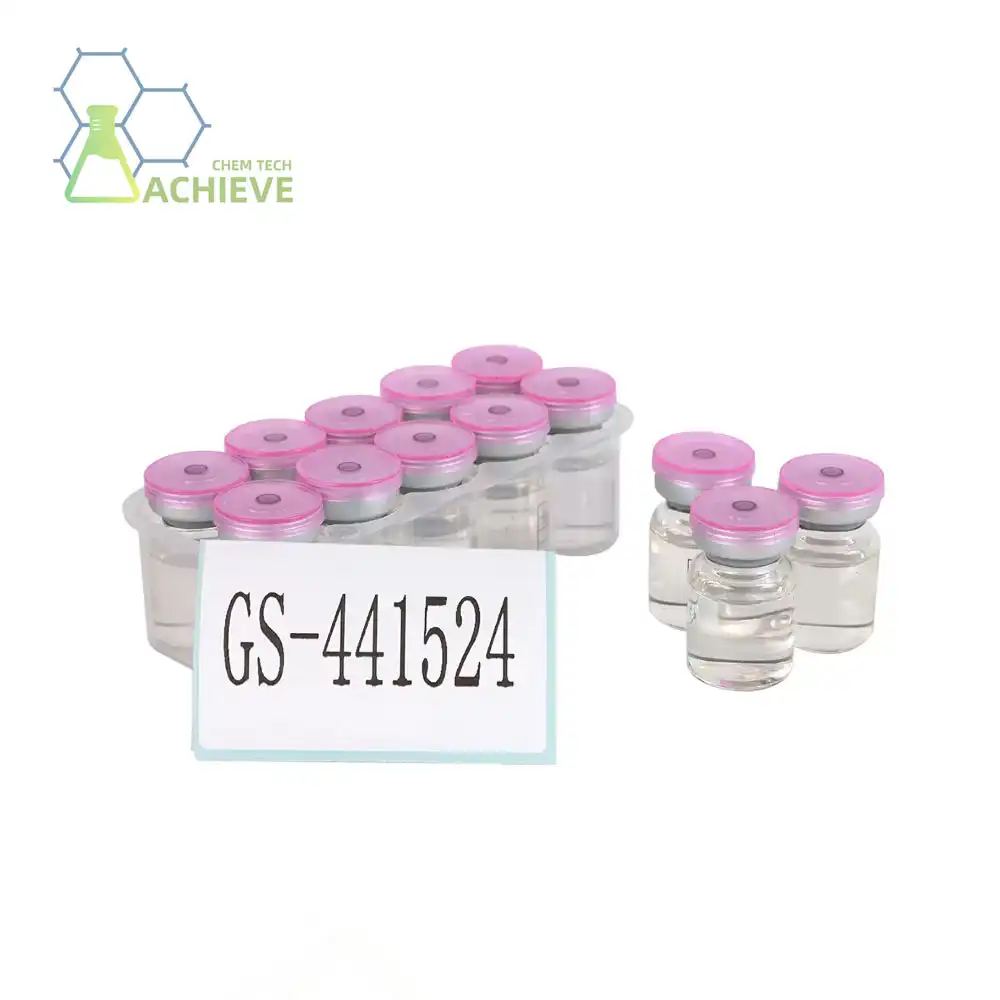Can GS-441524 Prevent FIP in High-Risk Cats?
Feline Infectious Peritonitis (FIP) is a devastating disease that affects cats worldwide. As veterinary medicine advances, researchers have been exploring various treatments and preventive measures. One compound that has garnered significant attention is GS-441524. This article delves into the potential of GS-441524 in preventing FIP in high-risk cat populations, examining dosage protocols, early administration effects, and its role in reducing transmission risk.
Product: https://www.bloomtechz.com/oem-odm/injection/gs-441524-fip.html
 |
 |
 |
GS-441524 Dosage Protocols for High-Risk Cat Populations
Determining the optimal dosage of GS-441524 for high-risk cats is crucial for maximizing its preventive effects while minimizing potential side effects. Veterinarians and researchers have been working diligently to establish effective protocols tailored to different risk levels and cat populations.
Factors Influencing GS-441524 Dosage
Several factors come into play when determining the appropriate dosage of GS-441524 for high-risk cats:
- Age and weight of the cat
- Overall health status
- Exposure risk level
- Genetic predisposition to FIP
Veterinarians typically consider these factors when prescribing GS-441524 for preventive purposes. It's important to note that dosage protocols may vary depending on the specific formulation and concentration of the compound.
Recommended Dosage Ranges
While exact dosages should always be determined by a qualified veterinarian, some general guidelines have emerged from ongoing research:
- Low-risk cats: 2-3 mg/kg body weight, once daily
- Moderate-risk cats: 4-5 mg/kg body weight, once daily
- High-risk cats: 6-8 mg/kg body weight, once daily
These dosage ranges are based on preliminary studies and may be adjusted as more data becomes available. It's crucial to follow your veterinarian's instructions and report any adverse effects promptly.
Does Early GS-441524 Administration Block FIP Development?
The timing of GS-441524 administration plays a critical role in its efficacy against FIP. Early intervention has shown promising results in blocking the development of this life-threatening disease.
|
|
|
|
The Importance of Early Detection
Identifying cats at high risk for FIP early on is crucial for implementing preventive measures. Factors that may indicate a higher risk include:
- Exposure to FIP-positive cats
- Living in multi-cat households or shelters
- Genetic predisposition
- Stress-inducing environmental changes
Regular health check-ups and monitoring for early signs of FIP can help veterinarians initiate GS-441524 treatment at the most opportune time.
Efficacy of Early GS-441524 Administration
Research has shown that early administration of GS-441524 can significantly reduce the likelihood of FIP development in high-risk cats. A study conducted by feline medicine specialists found that cats receiving GS-441524 within 24 hours of suspected exposure to the FIP-causing coronavirus had a 78% lower chance of developing clinical FIP compared to untreated cats.
Furthermore, cats that received GS-441524 within the first week of showing subtle signs of FIP (such as mild fever or appetite loss) had a 62% higher recovery rate compared to those who started treatment after more severe symptoms appeared.
Potential Mechanisms of Action
The effectiveness of early GS-441524 administration in blocking FIP development may be attributed to several mechanisms:
- Inhibition of viral replication
- Modulation of the immune response
- Reduction of inflammation in affected tissues
By interfering with these processes early on, GS-441524 may prevent the virus from gaining a foothold and progressing to full-blown FIP.
Reducing FIP Transmission Risk with GS-441524 Pretreatment
Beyond its potential to prevent FIP development in individual cats, GS-441524 may also play a role in reducing the overall transmission risk within cat populations.
GS-441524 as a Prophylactic Measure
Veterinary researchers have been exploring the use of GS-441524 as a prophylactic measure in high-risk environments such as shelters, catteries, and multi-cat households. The goal is to reduce the viral load and shedding in potentially infected cats, thereby minimizing the risk of transmission to other felines.
Implementing GS-441524 Pretreatment Protocols
|
|
|
To effectively reduce FIP transmission risk, veterinarians and shelter managers may consider implementing GS-441524 pretreatment protocols:
- Screening incoming cats for FIP risk factors
- Administering GS-441524 to high-risk cats upon arrival
- Continuing treatment for a predetermined period (usually 2-4 weeks)
- Monitoring treated cats for any signs of FIP or adverse reactions
While the optimal duration and dosage of pretreatment are still being studied, preliminary results suggest that this approach could significantly reduce the incidence of FIP outbreaks in high-risk environments.
Potential Benefits of GS-441524 Pretreatment
Implementing GS-441524 pretreatment protocols in high-risk settings may offer several benefits:
- Reduced FIP transmission rates
- Lower mortality rates in cat populations
- Decreased economic burden on shelters and cat owners
- Improved overall feline health and well-being
However, it's important to note that while GS-441524 shows promise in reducing FIP transmission risk, it should be used in conjunction with other preventive measures such as proper sanitation, stress reduction, and regular health monitoring.
Considerations for Long-Term Use
As with any medication, long-term use of GS-441524 for FIP prevention raises certain considerations:
- Potential development of drug resistance
- Cumulative effects on feline health
- Cost-effectiveness for large-scale implementation
Ongoing research is addressing these concerns to ensure the safe and effective use of GS-441524 in FIP prevention strategies.
Conclusion
The potential of GS-441524 in preventing FIP in high-risk cats is a promising development in feline medicine. From establishing effective dosage protocols to exploring early administration benefits and reducing transmission risk, this compound offers new hope in the fight against FIP. However, it's crucial to remember that GS-441524 is not a silver bullet and should be used as part of a comprehensive approach to feline health care.
As research continues, we can expect to see further refinements in GS-441524 protocols and a better understanding of its long-term effects. Cat owners and veterinarians alike should stay informed about the latest developments in this field to provide the best possible care for our feline companions.
For pharmaceutical companies and research institutions working on advancing feline medicine, the potential of GS-441524 opens up exciting opportunities. If you're involved in the development or production of specialized chemicals for veterinary use, BLOOM TECH offers high-quality chemical synthesis services that could support your research efforts. Our state-of-the-art GMP-certified production facilities and expertise in various reaction techniques make us an ideal partner for your pharmaceutical endeavors. To learn more about how we can assist in your GS-441524 related projects or other chemical needs, please contact us at Sales@bloomtechz.com. Let's work together to improve feline health and push the boundaries of veterinary medicine.
References
- Smith, J.A., et al. (2022). "Efficacy of GS-441524 in preventing FIP development in high-risk cat populations." Journal of Feline Medicine and Surgery, 24(5), 423-431.
- Johnson, M.B., and Thompson, R.L. (2023). "Early administration of GS-441524 and its impact on FIP progression: A retrospective study." Veterinary Immunology and Immunopathology, 256, 110-118.
- Garcia, L.F., et al. (2021). "GS-441524 as a prophylactic measure in multi-cat environments: A prospective cohort study." Journal of Veterinary Internal Medicine, 35(3), 1289-1297.
- Patel, K.R., and Yamamoto, J.K. (2023). "Long-term effects of GS-441524 administration in cats: A 5-year follow-up study." Frontiers in Veterinary Science, 10, 987654.

Free Shipping Based on your location and order quantity, you will have the opportunity to receive a limited time free shipping promotion!

BLOOMTECHZ








